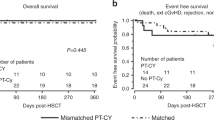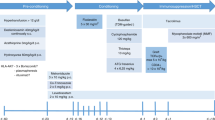Abstract
To augment graft cell dose, we evaluated the safety of the combined transplantation of two partially HLA-matched umbilical cord blood (UCB) units. Five patients with transfusion-dependent thalassemia, median age 11.1 years (range 10–13.1), received 2 UCB units after myeloablative conditioning. Cord blood units were a 4/6-HLA-match or better with the recipient, and contained a minimum combined pre-freeze CD34 cell dose of 3.0 × 105/kg. All patients engrafted at a median of 15 days (range 12–19). Four patients with durable trilineage engraftment showed acute grade I–III GVHD; none developed extensive chronic GVHD until the date of last contact. The median times to red blood cell transfusion independence and platelet engraftment were 32 and 49 days after transplant, respectively. With a median follow-up of 18.5 months (range 11–32), four patients transplanted with UCB from two different partially HLA-matched donors were transfusion-independent. Therefore, transfusion of two partially HLA-matched UCB units is safe, and may overcome the cell-dose barrier that limits the use of UCB in long-term recipients of multiple transfusions for thalassemia.
This is a preview of subscription content, access via your institution
Access options
Subscribe to this journal
Receive 12 print issues and online access
$259.00 per year
only $21.58 per issue
Buy this article
- Purchase on Springer Link
- Instant access to full article PDF
Prices may be subject to local taxes which are calculated during checkout
Similar content being viewed by others
References
La Nasa G, Caocci G, Argiolu F, Giardini C, Locatelli F, Vacca A et al. Unrelated donor stem cell transplantation in adult patients with thalassemia. Bone Marrow Transplant 2005; 36: 971–975.
Bosi A, Bartolozzi B, Guidi S . Allogeneic stem cell transplantation. Transplant Proc 2005; 37: 2667–2669.
Fleischhauer K, Locatelli F, Zecca M, Orofino MG, Giardini C, De Stefano P et al. Graft rejection after unrelated donor hematopoietic stem cell transplantation for thalassemia is associated with nonpermissive HLA-DPB1 disparity in host-versus-graft direction. Blood 2006; 107: 2984–2992.
Hongeng S, Pakakasama S, Chaisiripoomkere W, Chuansumrit A, Sirachainan N, Ungkanont A et al. Outcome of transplantation with unrelated donor bone marrow in children with severe thalassemia. Bone Marrow Transplant 2004; 33: 377–379.
Wagner JE, Barker JN, DeFor TE, Barker KS, Blazar BR, Eide C et al. Transplantation of unrelated donor umbilical cord blood in 102 patients with malignant and nonmalignant diseases: influence of CD34 cell dose and HLA disparity on treatment-related mortality and survival. Blood 2002; 100: 1611–1618.
Benito AI, Diaz MA, Gonzalez-Vicent M, Sevilla J, Madero L . Hematopoietic stem cell transplantation using umbilical cord blood progenitors: review of current clinical results. Bone Marrow Transplant 2004; 33: 675–690.
Laughlin MJ, Barker J, Bambach B, Koc ON, Rizzieri DA, Wagner JE et al. Hematopoietic engraftment and survival in adult recipients of umbilical-cord blood from unrelated donors. N Engl J Med 2001; 344: 1815–1822.
Goldstein G, Toren A, Nagler A . Human umbilical cord blood biology, transplantation and plasticity. Curr Med Chem 2006; 13: 1249–1259.
Majhail NS, Brunstein CG, Wagner JE . Double umbilical cord blood transplantation. Curr Opin Immunol 2006; 18: 571–575.
Moroff G, Eichler H, Brand A, Kekomaki R, Kurtz J, Letowska M et al. Multiple-laboratory comparison of in vitro assays utilized to characterize hematopoietic cells in cord blood. Transfusion 2006; 46: 498–500.
Grewal SS, Barker JN, Davies SM, Wagner JE . Unrelated donor hematopoietic cell transplantation: marrow or umbilical cord blood? Blood 2003; 101: 4233–4244.
Tse W, Laughlin MJ . Umbilical cord blood transplantation: a new alternative option. Hematology (Am Soc Hematol Educ Program) 2005, 377–383.
Locatelli F, Rocha V, Reed W, Bernaudin F, Ertem M, Grafakos S et al. Related umbilical cord blood transplantation in thalassemia and sickle cell anemia. Blood 2003; 101: 2137–2143.
Goussetis E, Peristeri J, Kitra V, Kattamis A, Petropoulos D, Papassotiriou I et al. Combined Cord-Blood and Bone Marrow Transplantation for Beta-Thalassemia. Pediatr Hematol Oncol 2000; 17: 307–314.
Ho WL, Lin KH, Wang JD, Hwang JS, Chung CW, Lin DT et al. Financial burden of national health insurance for treating patients with transfusion-dependent thalassemia in Taiwan. Bone Marrow Transplant 2006; 37: 569–574.
Li CK, Lai DH, Shing MM, Chik KW, Lee V, Yuen PM . Early iron reduction programme for thalassaemia patients after bone marrow transplantation. Bone Marrow Transplant 2000; 25: 653–656.
Bornstein R, Flores AI, Montalbán MA, del Rey MJ, de la Serna J, Gilsanz F . A modified cord blood collection method achieves sufficient cell levels for transplantation in most adult patients. Stem Cells 2005; 23: 324–334.
Migliaccio AR, Adamson JW, Stevens CE, Dobrila NL, Carrier CM, Rubinstein P . Cell dose and speed of engraftment in placental/umbilical cord blood transplantation: graft progenitor cell content is a better predictor than nucleated cell quantity. Blood 2000; 96: 2717–2722.
Acknowledgements
We are indebted to the patients and their caretakers for participating in the externally audited results. We would like to thank Professor Delon Wu for his continued support of this program. This work was supported in part by grants from Chang Gung Memorial Hospital (CMRP G33020) and National Science Council (95-2314-B-182A-106).
Material contained in this paper has been presented at the following meetings:
1. Jaing TH. Unrelated cord blood transplantation for hemoglobinopathies. 4th Annual International Umbilical Cord Blood Transplantation Symposium; Los Angeles, CA, USA; May 19–20, 2006.
2. Jaing TH, Tan P, Chan LL, Rosenthal J, Wang B, Gjertson D, Petz L, Chow R. Unrelated Cord Blood Transplantation for Hemoglobinopathy. 11th Congress of the Asia Pacific Bone Marrow Transplantation; Nagoya, Japan; October 27–29, 2006.
3. Jaing TH, Tan P, Rosenthal J, Wang B, Gjertson D, Petz L, Chow R. Unrelated Cord Blood Transplantation (CBT) for Thalassemia. 48th American Society of Hematology Annual Meeting, Orlando, FL, USA; December 9–12, 2006.
Author information
Authors and Affiliations
Corresponding author
Rights and permissions
About this article
Cite this article
Jaing, TH., Yang, CP., Hung, IJ. et al. Transplantation of unrelated donor umbilical cord blood utilizing double-unit grafts for five teenagers with transfusion-dependent thalassemia. Bone Marrow Transplant 40, 307–311 (2007). https://doi.org/10.1038/sj.bmt.1705737
Received:
Revised:
Accepted:
Published:
Issue Date:
DOI: https://doi.org/10.1038/sj.bmt.1705737
Keywords
This article is cited by
-
Feasibility of cord blood bank in high altitude Abha: preclinical impacts
Cell and Tissue Banking (2018)
-
Quantitative monitoring of multi-donor chimerism: a systematic, validated framework for routine analysis
Bone Marrow Transplantation (2010)
-
Successful unrelated donor cord blood transplantation for chronic granulomatous disease
International Journal of Hematology (2010)
-
Umbilical cord blood transplantation for non-malignant diseases
Bone Marrow Transplantation (2009)
-
Current status of hematopoietic stem cell transplantation in Taiwan
Bone Marrow Transplantation (2008)



